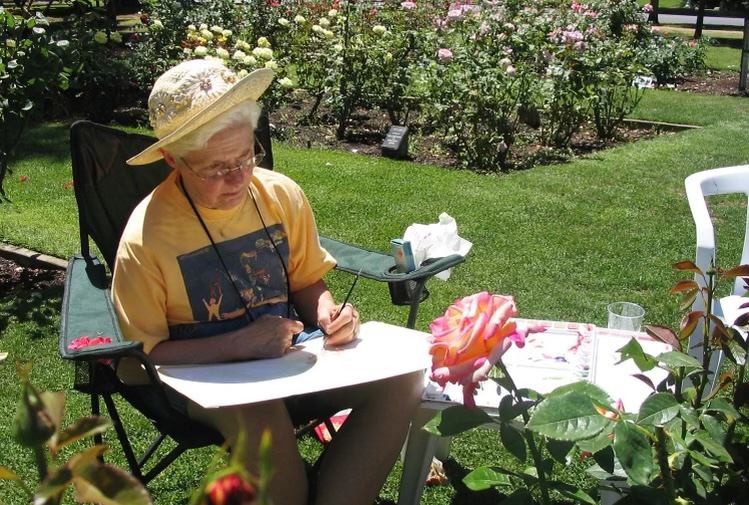
I already knew the answer. Out of habit, I suppose, I asked anyway. “How do you like it here?” It was a rainy springmorning when I dropped in on John, an eighty-four year-old family friend. He resided in an assisted living facility in my hometown of Springfield, Illinois. Since he was the Chaplain for the place, he occupied the equivalent of the penthouse suite. In all the decades I’ve known him, despite his underlying good nature, he has ha-bitch-ually passed the time by complaining about anything and everything. True to form, I found out that the food at this place was “terrible.” His fellow residents didn’t “talk loudly enough.” The staff deficiencies, while not malicious, were too numerous to list. By way of contrast, I walked down the hallway to see Jim Morris, the fella who mentored me through the hardest part of my adolescence. Since I’d last seen him, he’d moved into a single room on account of the death of his wife, Sue, nine months earlier. Unknowingly, I must have stumbled through some kind of Quantum Physics-related fluctuation in the time-space continuum. In this alternate universe, the food was “delicious.” “The staff couldn’t be any more helpful.” The fellow residents were “as friendly as can be.” I was hardly surprised. Whether in their home of forty years, or the nursing home, this was the universe that Jim and Sue had always occupied together. Jim was still hanging out in a world where hard things happened all the time, like the death of his “honey” of 55 years. But somehow, his well- trained eye could always detect something positive, even in the stark circumstances of diminishment and death. Beauty checks for him were not limited to nature landscapes. Decades of practice had taught Jim and his wife how to stop, drop and savor almost anywhere.
Positivity as Intentional Joy
Any meaningful research on the topic, will always list the loosely defined term, “positivity,” near the top of the characteristics evident in a resilient person’s life. Jim and his wife, Sue, fit that mold for as long as I knew them. Their liveswere marked with a kind of decisive joy that could not be reduced to favorable circumstances. Real intelligence was consistently placed at the service of humor, games, art, and a kind of zaniness that’s hard to define, maybe easier to describe. For example, each year, the largest, most misshapen Christmas Tree imaginable would be wrangled through their front door. More bush than tree, this invasive species would demand between twenty-five to fifty square feet of living room real estate. If one tree didn’t fill that space, some years, a small forest of Christmas Bushes would be required.
Another illustration: as I paid my respects at Jim’s coffin a month ago, it occurred to me that this was not the very first wake to honor him. It wasn’t his first casket either. As a young man, Jim would joke with his wife that, “she’d better take out a good life insurance policy” on him. His tongue may have been set firmly in his cheek, but nonetheless, many times he explained that she couldn’t count on his longevity on account of his own father’s premature death. When he crossed the chronological threshold of that death, at 45, Sue planned and executed a surprise funeral home “visitation” in his honor,complete with a genuine coffin, Catholic-style kneeler, funeral flowers, and church candles. In the Morris household, positivity that takes shape in laughter, and joy were never left to chance. People were always busy looking for ways to shepherd a stray laugh, or to provide an intentional structure for corralling it.
Last week (SMC, Oct. 1) I mentioned how resilient living appears to provide the scaffolding for resilient dying. The intentional practice of joy in life, followed Sue to her deathbed. I was able to join the family years ago as they sat vigil around her. It was late. The nurse on staff either forgot about us, or was allowing us to bend the visiting-hour rules. A clandestine party broke out that included contraband wine for toasting. Sue was such a great audience for off-color humor. She’d get herself caught in a hilarious circularity where she’d laugh at herself for laughing at something she didn’t think proper to laugh at, which in turn, would cause more laughter… and so on…. At her deathbed, whatever part of Sue’s self that was present beyond consciousness, would have thoroughly appreciated the hard laughter and futile attempts to suppress it to avoid curfew enforcement. One more time, her children were trying to get away with teen-aged antics. This time, Sue got to be one of the teens!

Defiant, Intentional Positivity
In his research on those who survive nature accidents, Lawrence Gonzalez, found that each of his subjects displayed a thing that, in the Marines, is called a “positive mental attitude.” In each of the stories of his survivors, that attitude was revealed in the way that they would look for “one next right thing” they could to do in their dire circumstances to increase their chances of survival.
Through her whole life, Sue was an excellent artist. The realism of her water color paintings was especially stunning. She passed that aesthetic gene along to at least three professional artist-children. This, in part, is what made her Parkinson’s Disease especially heartbreaking. Over time, her brush-wielding right hand grew progressively more erratic and less responsive to her brain’s commands. The way that Sue handled this tragic loss reminded me of Gonzalez’s survivors. As if Edna St. Vincent Millay’s verse, “I shall die, but that is all I shall do for death,” were her mantra, Sue adapted. She taught herself how to paint and draw with her left hand. Like Joni Mitchell’s recent return to the stage, until weeks before Sue’s death, what her art lacked in technical skill, was more than made up for in the depth of soul it expressed.
Far from an unrealistic polyanna-ish approach to things, positivity, for the resilient, is more conviction than whimsy, more cast iron that gossamer. And positivity, like the resilience it creates, is not so much a heritable trait as a muscle that grows in proportion to its intentional and habitual use.
Questions for Conversation:
• When was the last time you conducted a Beauty Check? When was the last time that you intentionally engaged in the practice of Stop, Drop, Savor?
• Who are the people in your life that cause you to laugh? Do you spend much time with them? Is the laughter based in positivity?
• When, like Sue, have you had to adapt? When have you had to look for “the next right thing” to do in a very difficult circumstance?

Oh I miss Sue so much!
Tom you described her in ways I didn’t see or know. But her ‘intentional practice of joy” I did see. Thank you for the words. God bless.